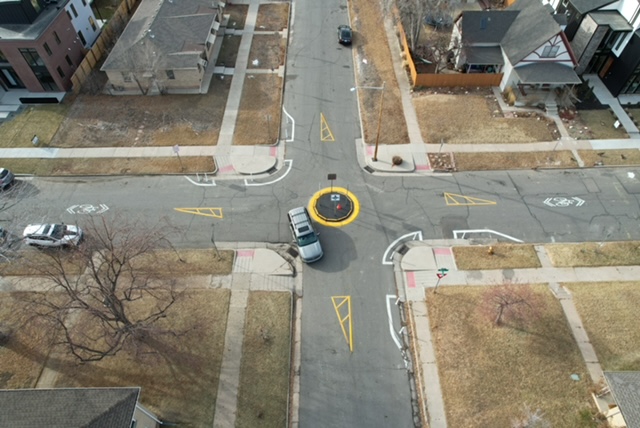By Allen Cowgill
Residents in Sunnyside, Berkeley, and Sloan’s Lake have around 10 new traffic circles on both Perry Street and W. 41st Avenue.
The traffic circles are part of the new neighborhood bikeways that the Denver Department of Transportation and Infrastructure (DOTI) is installing along the streets. They are part of the build of the Northwest Community Transportation Network and DOTI’s goal of making biking more comfortable and safe throughout North Denver.
The streets join W. 35th Avenue, which already has a handful of traffic circles between Federal Boulevard and Tennyson Street that were installed a few years ago as part of that street’s neighborhood bikeway. The department is not only installing the traffic circles for people that bike, but also to slow down traffic to make the streets more friendly and safe for people that are walking and rolling in wheelchairs.
DOTI Spokesperson Vanessa Lacayo said the department places the traffic circles on streets that are low speed and low volume (typically less than 2,000 cars per day). Research validates that traffic circles will increase safety along the streets.
According to the U.S. Department of Transportation, installing traffic circles where there was previously a two-way stop sign led to an 82% reduction in fatal and injury crashes. They are also one of 20 evidence-based safety improvements recommended by the Federal Highway Administration.
The new traffic circles are being installed with yield signs at all four sides of the intersection, and the original traffic circles along 35th Avenue were changed from two-way stops to four-way yields. The ones along 35th Avenue were also upgraded to make it easier to maintain.
Lacayo said the change to four-way yields from the original design happened because “we believe that using an all-way yield control is more appropriate and safer at a traffic circle treatment. The yield signs require all vehicles to reduce their speed or stop when approaching the intersection for anyone in the intersection with the right-of-way.”
Some residents have noticed not all drivers are aware of how to use the new traffic circles. Ryan Frazer, who lives in the West Highland neighborhood near the new traffic circles, said some drivers are confused about how to treat traffic circles. But he said the change DOTI made to an all-way yield from a two-way stop sign with a traffic circle is a much more conventional approach.
“The old setup was a little confusing, I’d never seen anything like that before,” he said.
Lacayo said DOTI recognizes the adjustment people have to make to the new circles. “Our goal, and what we are starting to see, is that more drivers are slowing down as they pass through these new traffic circles,” she said. “We will be collecting data on these sites to see how effective they are long term and what improvements can be made.”

She also noted that DOTI has worked to make sure the traffic circles are designed so that fire trucks and school buses can get through them.
So what is the proper way to drive or bike through traffic circles?
Lacayo said drivers should yield or stop to give the right-of-way to anyone—whether vehicles, pedestrians, or cyclists— who is already in the intersection or those who arrived first at the intersection. If two vehicles arrive at exactly the same time, Colorado law dictates that the car to the immediate right has the right-of-way and should go first.
Frazer said the traffic circles have made it more stressful for him as a driver, a pedestrian, and as someone who bikes. In particular he would like to see crosswalks at all of the roundabouts to make it more clear that pedestrians have the right-of-way when crossing. He looked it up and painted crosswalks are recommended by the National Association of City Transportation Officials (NACTO).
“It seems like pedestrians have the least priority compared to everyone else going through those,” he said. “We walk through them to go to the playground at Edison Elementary, and even if cars are driving parallel through the traffic circle to us, it feels like cars are going to drive into us if we are going to cross Raleigh, for example. That makes it a little stressful for us.”
He said he has also found it stressful when making a left turn in his car. He noted that a lot of drivers don’t yet realize that it’s different from a typical intersection in that you have to yield to vehicles that are already in the traffic circle making left turns, as opposed to typical intersections where the driver making a left turn would have to yield.
While he feels generally comfortable biking down the neighborhood bikeways himself, he didn’t feel that the traffic circles make the street more comfortable to bike with kids. Frazer said he hopes that DOTI will try out installing more diverters to reduce the volume of traffic since the department has shown a willingness to experiment with different concepts.
“In terms of these traffic circles being placed on neighborhood bikeways, in terms of them doing the job of slowing drivers down, it seems to work in the intersections themselves,” Frazer said. “But in between the intersections, it’s no different, so I’m not really sure that it’s going to do the job of slowing down drivers along the corridors.”
Lacayo says that DOTI will continue to study not only the traffic circles but all of the new treatments that they have put in and will be improving them based on their research.
The 2018 DOTI study when the first traffic circles were installed along 35th Avenue referenced that it typically takes six months for residents to get used to new infrastructure like this. It will be some time before we can understand long term impacts of community perception as well as vehicle speed impacts.

Be the first to comment